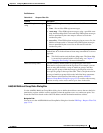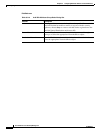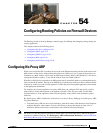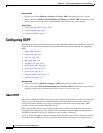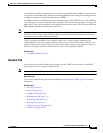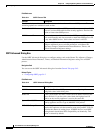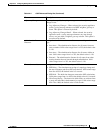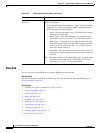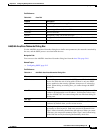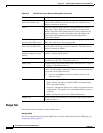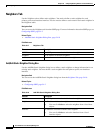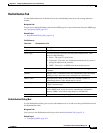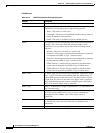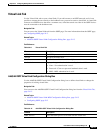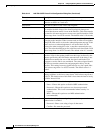
54-7
User Guide for Cisco Security Manager 4.4
OL-28826-01
Chapter 54 Configuring Routing Policies on Firewall Devices
Configuring OSPF
Field Reference
Add/Edit Area/Area Networks Dialog Box
Use the Add/Edit Area/Area Networks dialog box to define area parameters, the networks contained by
the area, and the OSPF process associated with the area.
Navigation Path
You can access the Add/Edit Area/Area Networks dialog box from the Area Tab, page 54-6.
Related Topics
• Configuring OSPF, page 54-2
Field Reference
Table 54-3 Area Tab
Element Description
OSPF Process The OSPF process the area applies to.
Area ID The area ID.
Area Type The area type (Normal, Stub, or NSSA).
Networks The area networks.
Options The options, if any, set for the area type.
Authentication The type of authentication set for the area (None, Password, or MD5).
Cost The default cost for the area.
Table 54-4 Add/Edit Area/Area Networks Dialog Box
Element Description
OSPF Process When adding a new area, choose the OSPF process ID for the OSPF
process for which the area is being added. If there is only one OSPF
process enabled on the security appliance, that process is selected by
default. When editing an existing area, you cannot change the OSPF
process ID.
Area ID When adding a new area, enter the area ID. You can specify the area ID
as either a decimal number or an IP address. Valid decimal values range
from 0 to 4294967295. You cannot change the area ID when editing an
existing area.
Area Type
Normal Choose this option to make the area a standard OSPF area. This option
is selected by default when you first create an area.
Stub Choosing this option makes the area a stub area. Stub areas do not have
any routers or areas beyond it. Stub areas prevent AS External LSAs
(Type 5 LSAs) from being flooded into the stub area. When you create
a stub area, you can prevent summary LSAs (Type 3 and 4) from being
flooded into the area by deselecting the Summary check box.



